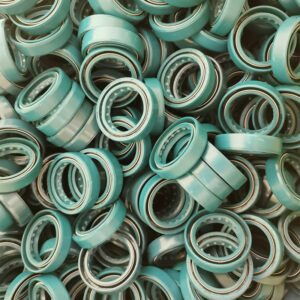Table of Contents
ToggleWhat is the Difference Between an Oil Gasket and an Oil Seal?
Understanding the distinction between oil gaskets and oil seals is critical for selecting the right sealing solution in mechanical systems. While both components prevent fluid leakage, their roles, designs, and applications differ fundamentally. This guide explores their key differences in detail, focusing on functionality, construction, materials, installation, and operational requirements.


Definitions
Oil Gasket
An oil gasket is a static sealing element designed to fit between two stationary, flat surfaces, such as an engine block and oil pan. Its primary purpose is to fill microscopic irregularities in mating surfaces to prevent oil leakage under pressure or temperature fluctuations. Gaskets are manufactured from compressible materials like rubber, cork, metal, graphite, or PTFE, chosen for their resistance to oil, heat, and chemicals. Since they rely on compression between flanges, oil gaskets are exclusively used in non-moving interfaces (dmsseals.com).
Oil Seal
An oil seal (also called a shaft seal or rotary seal) is a dynamic sealing component installed around rotating or reciprocating shafts, such as crankshafts or camshafts. Its dual function is to retain lubricants within a housing (e.g., gearboxes, engines) and exclude contaminants like dust and moisture. Oil seals typically consist of an elastomeric lip bonded to a metal case, ensuring a tight interference fit on the shaft. They accommodate movement while maintaining sealing integrity under dynamic conditions (nokcn-seals.com).
Key Differences
1. Static vs. Dynamic Operation
- Oil Gasket:
- Operates as a static seal, meaning it functions only between stationary surfaces.
- Relies on compression from bolted joints to seal gaps.
- Cannot adapt to movement; disassembly is required for replacement.
- Oil Seal:
- Functions as a dynamic seal, maintaining contact with moving parts (e.g., rotating shafts).
- Uses a flexible lip to accommodate motion, vibration, and slight misalignment.
- Designed for continuous operation under friction and heat (Blaylock Gasket).
2. Design and Construction
- Oil Gasket:
- Flat or custom-shaped (e.g., stamped, laser-cut) to match flange contours.
- Materials prioritize compressibility and chemical resistance (e.g., nitrile rubber, PTFE, metal composites).
- Oil Seal:
- Circular design with a metal outer ring and elastomeric inner lip.
- Combines structural rigidity (metal case) with flexibility (rubber lip) for dynamic performance.
- Often includes a spring to enhance lip tension against the shaft (dmsseals.com).
3. Material Requirements
- Oil Gasket:
- Selected based on temperature range, pressure resistance, and compatibility with oils/fluids.
- Common materials: cork (low-cost, compressible), rubber (flexible), metal (high-pressure).
- Oil Seal:
- Requires wear-resistant elastomers (e.g., nitrile rubber, Viton®, silicone) to withstand friction.
- Metal cases provide structural support and ensure a secure fit in housings (nokcn-seals.com).
4. Installation Methods
- Oil Gasket:
- Placed between two stationary surfaces (e.g., engine block and oil pan).
- Bolted or clamped in place, often with adhesive sealants for added security.
- Oil Seal:
- Pressed or driven into a bore or housing using specialized tools.
- Designed for a snug fit around the shaft, sometimes secured with snap rings or retaining plates.
5. Functional Priorities
- Oil Gasket:
- Focuses on sealing static joints to prevent oil leaks.
- Does not protect against external contaminants.
- Oil Seal:
- Retains oil while excluding contaminants (dust, water, debris).
- Critical for extending the lifespan of bearings and rotating components.
6. Maintenance and Lifespan
- Oil Gasket:
- Typically replaced during equipment disassembly (e.g., engine rebuilds).
- Longevity depends on surface finish, bolt torque accuracy, and operating conditions.
- Oil Seal:
- Lasts thousands of operating hours but may degrade due to lip wear, hardening, or spring failure.
- Requires periodic inspection in high-stress environments (dmsseals.com).
Applications
Oil Gaskets
- Common Uses:
- Engine oil pans, valve covers, cylinder heads, and intake manifolds.
- Hydraulic system flanges, pipe joints, and static lubrication interfaces.
- Example: A cylinder head gasket seals combustion chambers and coolant/oil passages in engines.
Oil Seals
- Common Uses:
- Crankshaft and camshaft ends, transmission shafts, wheel hubs, and pump shafts.
- Any rotating component exiting a lubricated housing.
- Example: A crankshaft rear main seal prevents oil leakage from the engine while accommodating shaft rotation.
Material Comparison Table
| Aspect | Oil Gasket | Oil Seal |
| Primary Material | Rubber, cork, PTFE, metal composites | Nitrile rubber, Viton®, silicone, metal cases |
| Key Property | Compressibility, chemical resistance | Wear resistance, thermal stability |
| Operational Focus | Static pressure sealing | Dynamic friction and contaminant exclusion |
Summary
The critical difference between oil gaskets and oil seals lies in their operational environment:
- Oil gaskets are static seals for stationary joints, relying on compression to block leaks.
- Oil seals are dynamic seals for moving parts, combining elastomeric flexibility with structural durability to retain oil and block contaminants.
Choosing the right component depends on factors such as motion (static vs. dynamic), pressure, temperature, and the need for contaminant exclusion. By understanding these differences, engineers and technicians can optimize sealing performance and equipment reliability.



Leave A Comment